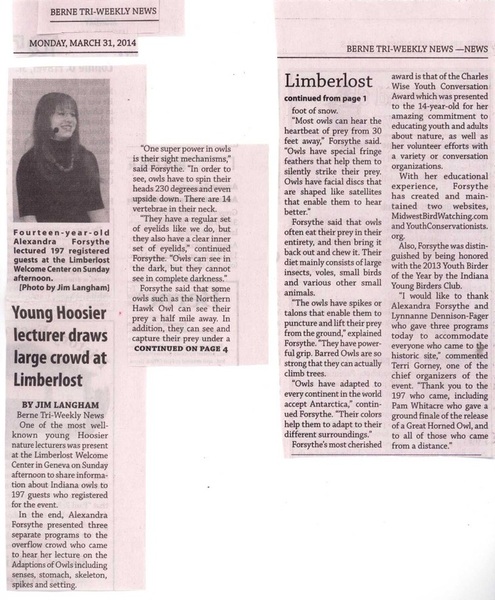
I have had the pleasure of working with the wonderful people at Limberlost State Historic Site to develop programs designed to encourage students to increase their awareness of the natural world. We’re creating in-house and outreach programs that cover a variety of interests from nature-friendly landscaping to the unique and diverse ways in which birds are beneficial to people. The in-house program I gave at Limberlost in late March focused on the owls of Indiana, their incredible adaptations, raptor rehabilitation and the many ways people can help these fascinating birds. The article attached to this blog describes some of that program. There are a few typos (owls do not dine on their pellets, they can turn their heads 270 degrees, etc.), but it is a very nice article. I was pleased to see that there was so much interest; I had to give the presentation three times that day in order to accommodate the overflow crowd!
The outreach program is designed to be taught in schools. The first of these presentations was given to a school in early April. I discussed the various methods of bird identification (physical characteristics, sound, behavior, nests, etc.) and some of the commonly overlooked ways in which birds help us. For example, the Yellow-Billed Cuckoo will feast on up to 100 tent caterpillars per sitting and is one of the few birds that will eat fuzzy caterpillars. Imagine the number of fruit trees that would be damaged if it were not for these wonderful birds keeping the tent caterpillar population under control! At the time of this writing, we have been invited by additional school districts to give programs in early May, so I am very encouraged!
We’re planning to expand the programs to cover additional subjects so that we can reach a broader range of interests. We want the next generation to gain a deeper appreciation of the world around them. The world is in their hands!
The outreach program is designed to be taught in schools. The first of these presentations was given to a school in early April. I discussed the various methods of bird identification (physical characteristics, sound, behavior, nests, etc.) and some of the commonly overlooked ways in which birds help us. For example, the Yellow-Billed Cuckoo will feast on up to 100 tent caterpillars per sitting and is one of the few birds that will eat fuzzy caterpillars. Imagine the number of fruit trees that would be damaged if it were not for these wonderful birds keeping the tent caterpillar population under control! At the time of this writing, we have been invited by additional school districts to give programs in early May, so I am very encouraged!
We’re planning to expand the programs to cover additional subjects so that we can reach a broader range of interests. We want the next generation to gain a deeper appreciation of the world around them. The world is in their hands!
 RSS Feed
RSS Feed
